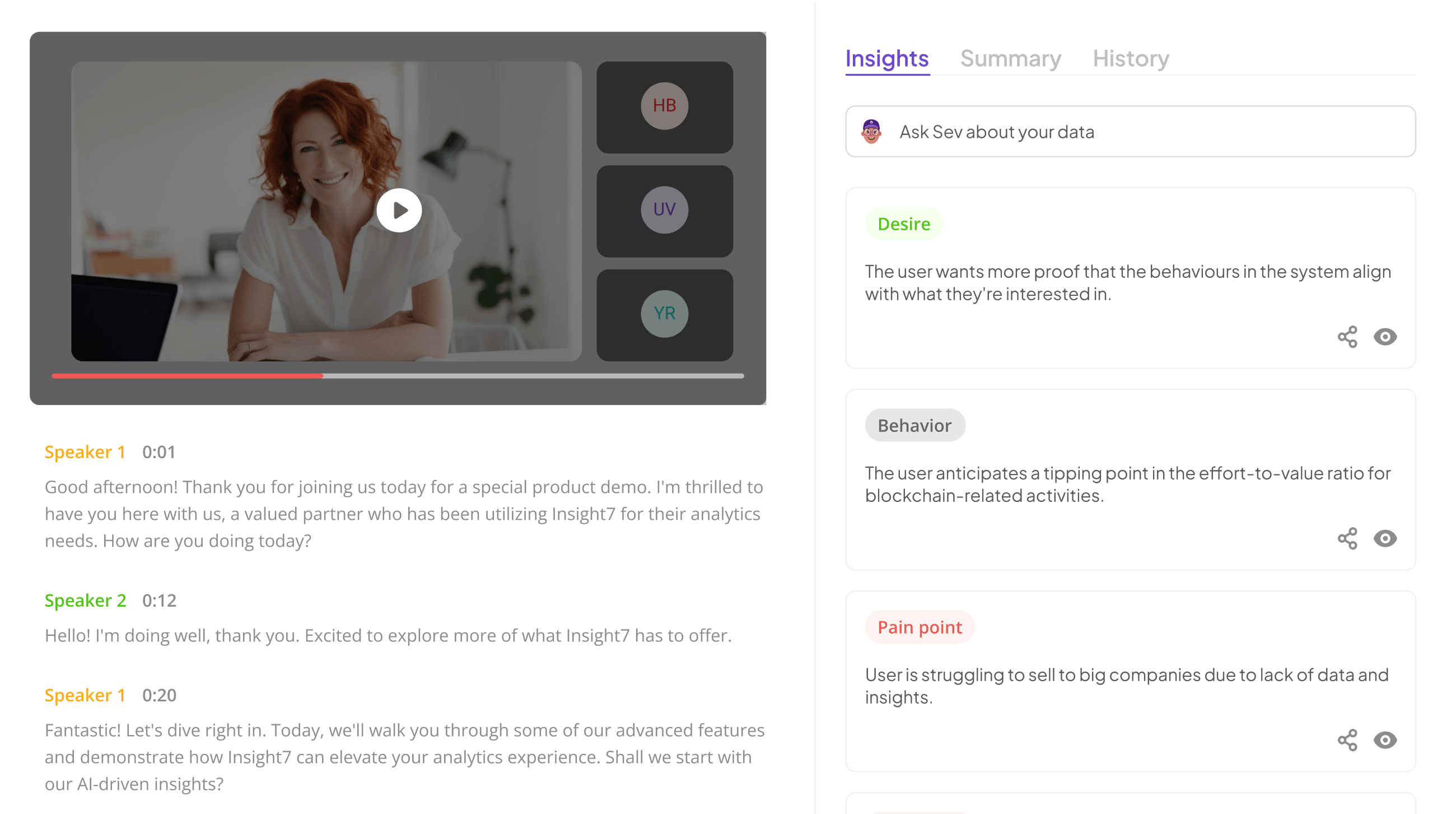5 Coaching Prompts to Improve Call-to-Meeting Rates
-
Bella Williams
- 10 min read
Meeting Conversion Techniques are essential for transforming prospects into valuable meetings. In a world filled with price shoppers and inquiries for advice, understanding how to engage effectively can significantly impact your call-to-meeting rates. By honing your communication skills and employing targeted strategies, you create opportunities that may otherwise slip through the cracks.
The journey begins with recognizing common challenges in converting calls into meetings. Many potential clients may contact you with genuine questions, yet fail to see the value in scheduling a meeting. Developing a system to identify and address these obstacles will empower your team to maximize conversion rates. Adapting your approach based on insights gained from each call can significantly enhance your effectiveness and lead to greater success.
Analyze & Evaluate Calls. At Scale.

Effective Meeting Conversion Techniques: Coaching Prompts
Effective Meeting Conversion Techniques play a crucial role in boosting call-to-meeting rates. To improve your success in this area, coaching prompts can serve as powerful tools. They encourage individuals to reflect, adapt, and refine their approaches in securing meetings with potential clients. Identifying what inspires clients to agree to a meeting can transform how outreach is carried out.
First, consider asking targeted questions such as, "What value can we provide in this meeting?" This prompts a focus on client needs and clarifies the benefits of attending. Next, explore the client's pain points by asking, "How can our solutions address your current challenges?" This not only shows empathy but also establishes a connection grounded in problem-solving. Ultimately, adopting these effective meeting conversion techniques helps elevate engagement and drive higher call-to-meeting rates.
Understanding the Importance of Call-to-Meeting Rates
Understanding call-to-meeting rates is crucial for enhancing your sales strategy. These rates provide insight into how effectively your outreach converts into actionable meetings. By examining this metric, teams can identify underlying challenges in their approach, whether that be in communication style, timing, or targeting. Understanding these rates enables organizations to tailor their strategies and ultimately achieve better outcomes.
To improve call-to-meeting rates, emphasize meeting conversion techniques. Start by training your team to understand customer needs through effective questioning. Encourage them to listen actively and personalize their approach based on the prospect’s responses. Moreover, assess and analyze past calls to uncover patterns that lead to successful meetings. This reflective practice can outline areas for development, ultimately driving higher meeting conversion rates and fostering stronger relationships with potential clients.
Common Challenges in Meeting Conversion
Meeting conversion is a crucial aspect of sales, but it often comes with its own set of challenges. One common hurdle is the influx of calls from potential clients who are primarily price shopping. These inquiries can dilute the sales process, making it harder to focus on converting genuine leads. Additionally, callers may be contacting your team with specific questions or issues rather than an intent to set a meeting, which complicates the conversion process.
Another significant challenge lies in effectively communicating the value of your services. Prospective clients may not fully understand how you can address their specific needs, leading to indecision and lackluster engagement. Misalignment between what the client values and what you present can further hinder successful meeting conversion. Addressing these challenges requires tailored meeting conversion techniques that connect the dots between client needs and your offerings, ensuring higher engagement and more successful meeting outcomes.
Tools to Enhance Call-to-Meeting Performance
To enhance call-to-meeting performance, it’s crucial to implement various tools designed to streamline processes. One effective approach involves adopting automated systems that help schedule meetings more efficiently. By minimizing manual intervention, sales teams have more time to focus on engaging prospects, ultimately increasing the likelihood of securing meetings. Additionally, investing in automated follow-up tools can improve engagement significantly, ensuring that prospects receive timely reminders and relevant information about their scheduled meetings.
These solutions facilitate a smoother transition from calls to meetings by eliminating common bottlenecks. Analyzing call data also empowers teams to identify specific customer interests and questions, which can inform training and lead to better performance. This data-driven strategy enables you to address potential issues proactively and refine your outreach methods. By integrating these tools into your workflow, you can markedly enhance your call-to-meeting conversion rates.
Insight7: Enhancing Conversion with Data-Driven Insights
Data-driven insights are essential for enhancing conversion rates in meeting setups. By analyzing customer interactions, businesses can pinpoint gaps in their communication strategies. Understanding how well your messaging resonates with potential clients is crucial for improving call-to-meeting rates. Gathering and examining data from previous interactions enables you to refine your approach based on real feedback.
To implement effective meeting conversion techniques, focus on three key areas: personalization, engagement, and follow-up. Personalized communication demonstrates that you understand each client's unique needs. Engaging clients with thoughtful questions can foster curiosity and dialogue. Lastly, timely follow-ups are vital to maintain interest and encourage scheduled meetings. Businesses that utilize data to guide these techniques are more likely to see an uptick in their meeting conversion success.
Extract insights from interviews, calls, surveys and reviews for insights in minutes
: Streamlining Scheduling for Better Rates
Streamlining scheduling can significantly impact call-to-meeting conversion rates. By utilizing a dedicated tool, you can effortlessly coordinate meetings, eliminating the common challenges of double bookings and scheduling conflicts. Simplified scheduling not only saves time but also enhances the overall experience for both you and your prospects. When scheduling becomes intuitive, the likelihood of securing more meetings increases, transforming potential opportunities into completed interactions.
Effective meeting conversion techniques include the use of personalized invitations and reminders, ensuring that every touchpoint is purposeful. Additionally, offering flexible time slots can cater to varying schedules, making it easier for potential clients to engage. By strategically organizing your calendar, you pave the way for higher engagement and better outcomes. Implementing these strategies will undoubtedly elevate your call-to-meeting rates, leading to improved business relationships and increased success in your endeavors.
: Automated Follow-Ups to Boost Engagement
Automated follow-ups are crucial for maintaining engagement and increasing call-to-meeting rates. This tool ensures that your leads receive timely reminders and additional information about your offerings, providing a gentle nudge towards scheduling a meeting. By automating this process, you can save valuable time while consistently communicating with potential clients. Personalized follow-ups help to reinforce your message, enhance your relationship, and build trust, which ultimately leads to improved meeting conversion rates.
Implementing automated follow-ups can be achieved in a few steps. First, customize your messaging to cater to different segments of your audience. Next, schedule follow-ups based on their interactions with your initial communications. Lastly, track the effectiveness of these follow-ups to refine your approach continuously. By utilizing this tool effectively, you will not only boost engagement but also enhance your overall strategy for meeting conversion techniques.
Conclusion on Meeting Conversion Techniques
Effective Meeting Conversion Techniques are essential for optimizing call-to-meeting rates. By applying the five coaching prompts outlined earlier, teams can identify and overcome barriers to conversion. It’s crucial to emphasize understanding client needs, addressing inquiries promptly, and providing valuable insights during calls. This approach not only enhances engagement but also paves the way for meaningful conversations that can lead to successful meetings.
To wrap up, mastering Meeting Conversion Techniques requires a commitment to continual improvement and adaptation. Continuous evaluation of call performance and client responses creates opportunities for learning and growth. When teams implement these strategies effectively, they will see an increase in successful meeting conversions and ultimately, greater success in achieving their goals.







